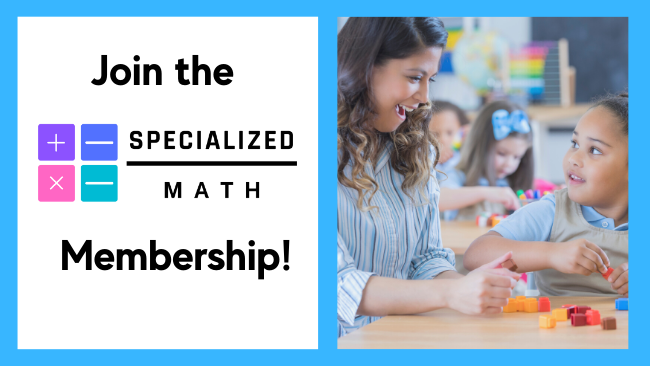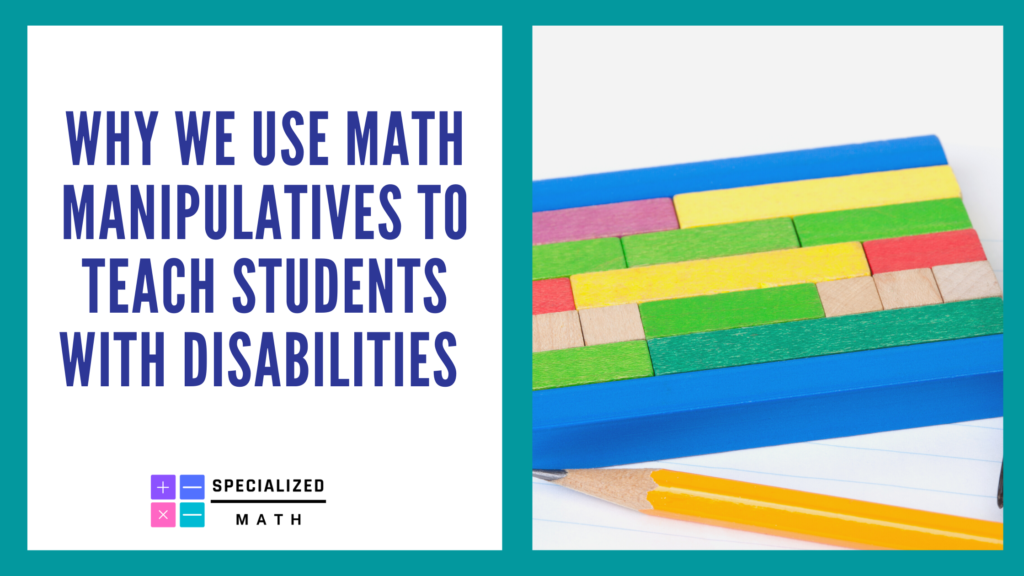Every students is not going to be able to reach a full understanding of math concepts in the same way. Students with disabilities and learning difficulties often need different levels of support depending on their needs.
Some students, especially those who are kinesthetic learners, may require additional time built in where they are able practice skills and concepts using concrete models. This can be done through the use of math manipulatives.
By giving students an opportunity to touch and move manipulatives we are encouraging them to have the ability to generalize their conceptual knowledge when we introduce pictorial support. The goal is for students to build upon their concrete and representational (pictorial), to then begin understanding abstract forms of mathematics. This method of teaching is grounded in the Concrete, Representational, and Abstract method.
Manipulative Lists by Grade Level
Below you will find a suggested manipulative resource list for each grade level. **Note that some of the links below are affiliate links for which I will receive a small commission if you decide to purchase from Amazon.
Kindergarten
Counters
Attribute Shapes
Tangrams
Ruler
Yard Stick/Meter Sticks
Tape Measure
Spring Scale
Balance Scale
Beakers
Linking Cubes
Place Value Discs
Dice
Two Sided Counters
Dry Erase Boards and Markers
Grade 1
Attribute Shapes
Tangrams
Ruler
Yard Stick
Meter Stick
Tape Measure
Spring Scale
Balance Scale
Beakers
Clocks.
Money Sets
Linking Cubes
Base Ten Blocks
Place Value Discs
Place Value Cards
Dice
Counters
Dry Erase Boards and Markers
Grade 2
Attribute Shapes
Tangrams
Area tiles
Geoboards and rubber bands
Ruler
Yard Stick/Meter Stick
Spring Scale
Balance Scale
Beakers
Clocks
Money sets
Linking cubes
Unifix Cubes
Base ten blocks.
Place Value Discs
Place Value Cards
Dice
Two-sided counters
Fraction circles
Fraction squares.
Dry erase board and markers
Grade 3
Attribute Shapes
Area tiles
Geoboards and rubber bands
Geometry Set
Ruler
Yard Stick
Meter Stick.
Tape Measure
Spring Scale
Balance Scale
Digital metric scale.
Beakers
Clocks.
Linking cubes
Unifix cubes
Base ten blocks
Place value discs (K-3 and 3-6)
Place value cards (4 digit and 7 digit)
Dice
Fraction circles
Two sided-counters
Fraction circles and squares
Dry erase board and markers
Grade 4
Area tiles
Ruler
Yard Stick
Meter Stick.
Tape Measure
Digital Metric Scale
Unifix cubes
Place value discs
Place value cards
Dice
White board and markers
Grade 5
Centimeter cubes
Ruler
Yard Stick
Meter Stick
Tape Measure
Decimal number discs
Place value cards
Dice
White board and markers
Virtual Manipulatives
Many times you may find that you do not have access to physical manipulatives. If you have access to technology, below are links to virtual manipulatives. These sites can also be used for virtual and distance learning:
Toy Theater Virtual Manipulatives
Utah State University National Library of Virtual Manipulatives
Connection to IEP Development
When considering that fact that many of our students with disabilities benefit from the use of manipulatives, it is important to consider this when developing IEPs. When writing IEP goals, determine whether the students will require manipulatives as a condition for them to achieve their annual goals. We can also see the use of manipulatives documented under Supplementary Aids and Services. In the Specialized Math membership, we have a full IEP Development course that focuses on how to write standards-based IEPs.
Sign up now to receive free resources that will support you in teaching math to students with disabilities.
If you are interested in becoming a member, click here to learn more about the Specialized Math Membership Site and gain access to resources to support students with disabilities in math.


